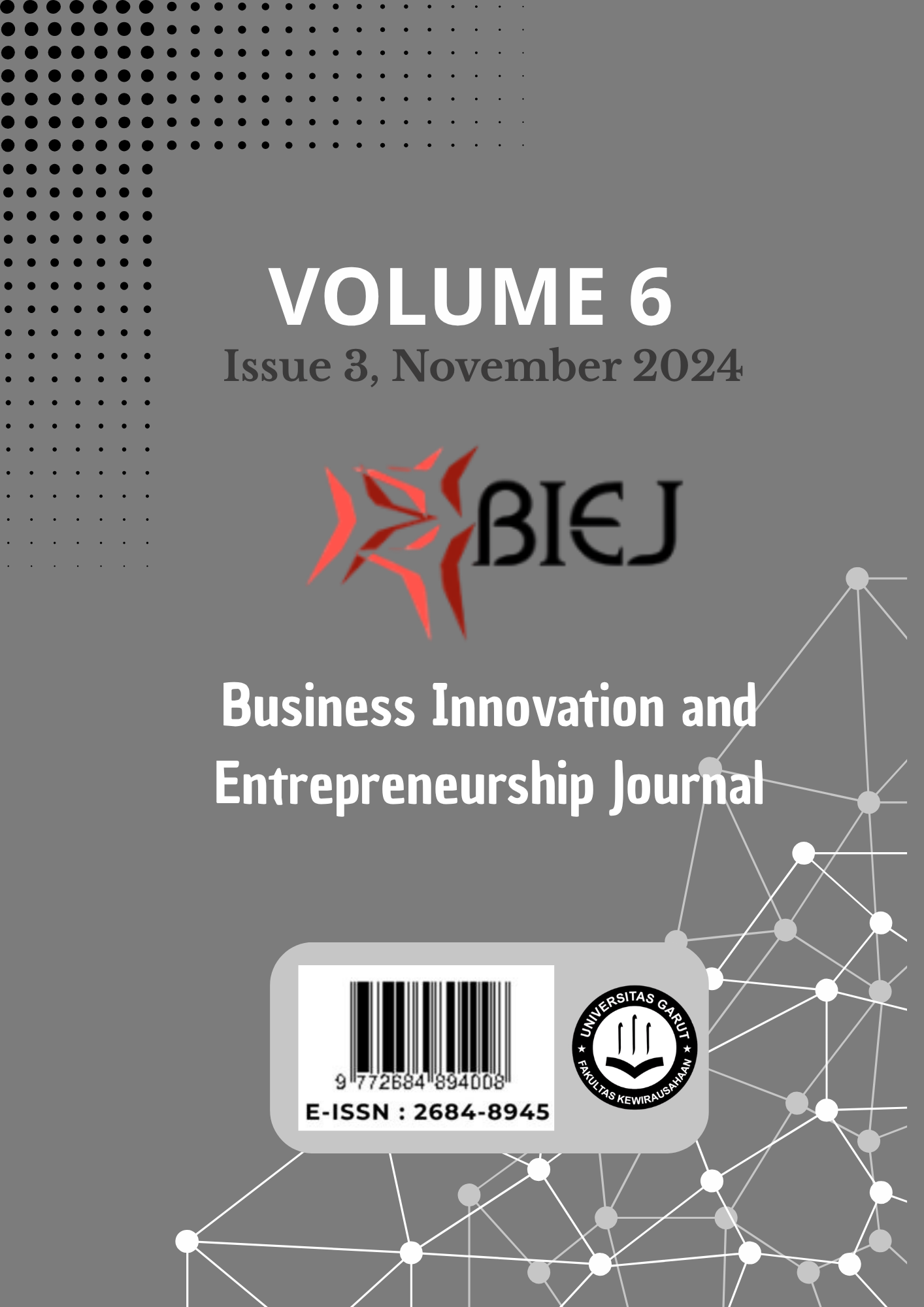Implementation of Green Business Strategy in Increasing Competitiveness of Manufacturing Companies
Abstract
Business management is becoming crucial for manufacturing companies looking to increase their competitiveness in a market that is increasingly focused on sustainability. Climate change and the negative impact of industrial activities on the environment have pushed companies to adopt more sustainable business practices. The purpose of this study is to analyze environmentally friendly businesses in improving competency in the manufacturing sector. This research method uses qualitative descriptive itself providing a framework that allows researchers to understand and describe the social context and behavior of individuals or groups, data collection techniques with observation, and analysis of documentation studies, data analysis techniques using data reduction, data presentation and data verification through Nvivo 12 software. The results of the data analysis identified that consistency in implementing green marketing practices contributed greatly to positive results in marketing. The implementation of green business strategies in the manufacturing industry not only contributes to environmental sustainability. Therefore, implementing environmentally friendly business management encourages the creation of good competence in the business sector.
Downloads
References
E. Afum, Y. Agyabeng‐Mensah, Z. Sun, B. Frimpong, L. Kusi, and I. Acquah, “Exploring the link between green manufacturing, operational competitiveness, firm reputation and sustainable performance dimensions: a mediated approach,” J. Manuf. Technol. Manag., vol. 31, no. 7, pp. 1417–1438, 2020, doi: 10.1108/jmtm-02-2020-0036.
B. J. Ali and G. Anwar, “Business strategy: The influence of Strategic Competitiveness on competitive advantage,” International Journal of Electrical, Electronics and …. academia.edu, 2021. [Online]. Available: https://www.academia.edu/download/66725890/g_12_9_Business_strategy_The_influence.pdf
J. Purwandani and G. Michaud, “What are the drivers and barriers for green business practice adoption for SMEs?,” Environ. Syst. Decis., vol. 41, no. 4, pp. 577–593, 2021, doi: 10.1007/s10669-021-09821-3.
A. Hussain, M. Akbar, A. Shahzad, P. Poulova, and ..., “E-commerce and SME performance: The moderating influence of entrepreneurial competencies,” Administrative …. mdpi.com, 2022.
N. Bi�akcioglu-Peynirci, V. Theoharakis, and M. Tanyeri, “Green business strategy and export performance,” Int. Mark. Rev., vol. 37, no. 1, pp. 56–75, 2019, doi: 10.1108/imr-11-2018-0317.
N. Madah, “The impact of green manufacturing strategies on organization competitive performance: a comparative study of opinions of a sample of departments operating in (northern cement associate) and (southern cement state,” Int. J. Prof. Bus. Rev., vol. 8, no. 5, p. e01532, 2023, [Online]. Available: https://doi.org/10.26668/businessreview/2023.v8i5.1532
D. Güzel, G. Korkmaz, and A. Asıabı, “Analysis effect of environmental orientation and organizational innovation on environmental talent development and performance,” Teh. Glas., vol. 18, no. 1, pp. 100–107, 2024, [Online]. Available: https://doi.org/10.31803/tg-20221229113838
P. Yadav, S. Han, and H. Kim, “Sustaining competitive advantage through corporate environmental performance,” Bus. Strateg. Environ., vol. 26, no. 3, pp. 345–357, 2016, [Online]. Available: https://doi.org/10.1002/bse.1921
S. Samad, “Examining the effects of environmental strategy and competitive advantage on business performance,” Manag. Sci. Lett., pp. 891–902, 2018, [Online]. Available: https://doi.org/10.5267/j.msl.2018.6.012
A. Gao, Y. Lin, and Y. Zhou, “Does an innovative climate help to sustain competitiveness? the moderating effect of government support and market competition,” Sustainability, vol. 12, no. 5, p. 2029, 2020, [Online]. Available: https://doi.org/10.3390/su12052029
D. Ćirić, T. Lolić, D. Gračanin, D. Stefanović, and B. Lаlić, “The application of ict solutions in manufacturing companies in serbia.,” 2020, pp. 122–129. [Online]. Available: https://doi.org/10.1007/978-3-030-57997-5_15
N. Yasa, N. Ekawati, P. Rahmayanti, and I. Tirtayani, “The role of tri hita karana-based business strategy and digital marketing to improve sustainable business performance,” Int. J. Data Netw. Sci., vol. 8, no. 1, pp. 629–640, 2024, [Online]. Available: https://doi.org/10.5267/j.ijdns.2023.8.022
M. Wedysiage, H. Semuel, and D. Deviesa, “Corporate social responsibility and competitive advantage: the evaluation of the mediation role of employee commitment and customer satisfaction, (study on manufacturing companies in surabaya),” Petra Int. J. Bus. Stud., vol. 4, no. 1, pp. 1–10, 2021, [Online]. Available: https://doi.org/10.9744/ijbs.4.1.1-10
I. Qurbani, “Implementation of the green economy concept in regulation of business competition in Indonesia,” 2023, pp. 326–333. doi: 10.2991/978-94-6463-140-1_32.
J. Liu, C. Shi, C. Yang, Z. Lu, and P. S. Yu, “A survey on heterogeneous information network based recommender systems: Concepts, methods, applications and resources,” AI Open. Elsevier, 2022.
S. Begum, M. Ashfaq, K. Asiaei, and K. Shahzad, “Green intellectual capital and green business strategy: the role of green absorptive capacity,” Bus. Strateg. Environ., vol. 32, no. 7, pp. 4907–4923, 2023, doi: 10.1002/bse.3399.
İ. Şener and M. Artar, “How green strategy research is evolving: a systematic literature review,” J. Glob. Strateg. Manag., 2024, doi: 10.20460/jgsm.2023.317.
M. Darkhabani, “The benefits and challenges of green business practices in the lebanese construction industry,” Indik. J. Ilm. Manaj. Dan Bisnis, vol. 6, no. 3, p. 1, 2022, doi: 10.22441/indikator.v6i3.15356.
N. Irawan and N. Aulia, “The nexus between green strategic consensus, innovation, and performance evidence from eco-friendly food agro-industry companies in indonesia,” in IOP Conference Series Earth and Environmental Science, 2022, vol. 1108, no. 1, p. 12033. doi: 10.1088/1755-1315/1108/1/012033.
W. Wang, D. Zhang, H. Wang, Z. Qing-xiang, and H. Heravi, “How do businesses achieve sustainable success and gain a competitive advantage in the green era?,” Kybernetes, vol. 52, no. 9, pp. 3241–3260, 2022, doi: 10.1108/k-07-2021-0614.
B. Barakat et al., “Assessing the impact of green training on sustainable business advantage: exploring the mediating role of green supply chain practices,” Sustainability, vol. 15, no. 19, p. 14144, 2023, doi: 10.3390/su151914144.
P. Palgunadi, R. Sanjaya, and C. Murniati, “Studi empiris persepsi pemimpin perusahaan tentang green business pada industri garmen di boyolali, klaten, dan yogyakarta: analisis fenomenologi interpretif,” Econbank J. Econ. Bank., vol. 5, no. 1, pp. 138–147, 2023, doi: 10.35829/econbank.v5i1.291.
O. al.obaidy, I. Ismael, and I. Alshammary, “The mediating role of operations management practices on the relationship between the dimensions of manufacturing flexibility and competitiveness,” Int. J. Prof. Bus. Rev., vol. 8, no. 5, p. e01375, 2023, doi: 10.26668/businessreview/2023.v8i5.1375.
L. Lu, “An empirical study on the international competitiveness of China’s manufacturing industry,” Financ. Eng. Risk Manag., vol. 6, no. 2, 2023, doi: 10.23977/ferm.2023.060212.
M. Vacchi, C. Siligardi, and D. Settembre-Blundo, “Driving manufacturing companies toward industry 5.0: a strategic framework for process technological sustainability assessment (P-TSA),” Sustainability, vol. 16, no. 2, p. 695, 2024, doi: 10.3390/su16020695.
D. Fokam, R. DEFFO, E. Youmto, and B. Kamga, “Free zones and manufactured export competitiveness from Africa,” Rev. Dev. Econ., vol. 28, no. 4, pp. 1345–1373, 2024, doi: 10.1111/rode.13103.
M. Zhang and M. Jedin, “Firm innovation and technical capabilities for enhanced export performance: the moderating role of competitive intensity,” Rev. Int. Bus. Strateg., vol. 33, no. 5, pp. 810–829, 2022, doi: 10.1108/ribs-01-2022-0015.
D. Bhattacharya, A. Aronsohn, J. Price, and ..., “Hepatitis C guidance 2023 update: american association for the study of liver diseases–infectious diseases society of america recommendations for testing, managing …,” Clin. Infect. …, 2023, doi: 10.1093/cid/ciad319/7179952.
W. Walisundara, N. Thevanes, and A. Arulrajah, “Green manufacturing practices and sustainable performance of organization in selected manufacturing companies in Kegalle district of Sri Lanka,” Vidyodaya J. Manag., vol. 8, no. II, 2022, doi: 10.31357/vjm.v8iii.6090.
N. Harikannan, S. Vinodh, and J. Antony, “Analysis of the relationship among industry 4.0 technologies, sustainable manufacturing practices and organizational sustainable performance using structural equation modelling,” TQM J., vol. 37, no. 1, pp. 42–72, 2023, doi: 10.1108/tqm-02-2023-0044.
A. Hermawan, I. Masudin, F. Zulfikarijah, D. Restuputri, and S. Shariff, “The effect of sustainable manufacturing on environmental performance through government regulation and eco-innovation,” Int. J. Ind. Eng. Oper. Manag., vol. 6, no. 4, pp. 299–325, 2023, doi: 10.1108/ijieom-04-2023-0039.
J. Kacani, “Resource efficiency in innovative textile and clothing industry ecosystems: evidence from western balkan countries,” 2023. doi: 10.33422/6th.icmbf.2023.06.103.
N. Bari, R. Chimhundu, and K. Chan, “Interrelation between sustainable dynamic capabilities, corporate sustainability, and sustained competitive advantage,” Sustainability, vol. 16, no. 7, p. 2864, 2024, doi: 10.3390/su16072864.
A. Maria Natalia Bete, “Peran Guru Dalam Mengatasi Bullying Di SMA Negeri Sasitamean Kecamatan Sasitamean Kabupaten Malaka,” J. Ilmu Pendidik., vol. 8, no. 1, 2023.
M. Dieste, R. Panizzolo, and J. Garza-Reyes, “A systematic literature review regarding the influence of lean manufacturing on firms’ financial performance,” J. Manuf. Technol. Manag., vol. 32, no. 9, pp. 101–121, 2021, doi: 10.1108/jmtm-08-2020-0304.
M. Battour, M. Barahma, and M. Al-Awlaqi, “The relationship between HRM strategies and sustainable competitive advantage: testing the mediating role of strategic agility,” Sustainability, vol. 13, no. 9, p. 5315, 2021, doi: 10.3390/su13095315.
J. W. Creswell, Research Design Pendekatan Kualitataif, Kuantitatif, dan Mixed. Yogyakarta: pustaka pelajar, 2016.
S. Adomako and M. D. Tran, “Sustainable environmental strategy, firm competitiveness, and financial performance: Evidence from the mining industry,” Resour. Policy, 2022, [Online]. Available: https://www.sciencedirect.com/science/article/pii/S0301420721005225
L. Qiu, X. Jie, Y. Wang, and M. Zhao, “Green Product Innovation, Green Dynamic Capability, and Competitive Advantage: Evidence From Chinese Manufacturing Enterprises,” Corp. Soc. Responsib. Environ. Manag., vol. 27, no. 1, pp. 146–165, 2019, doi: 10.1002/csr.1780.



























